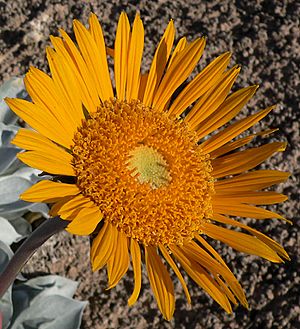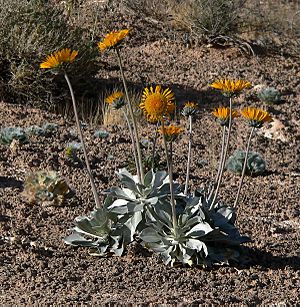Silverleaf sunray facts for kids
Quick facts for kids Silverleaf sunray |
|
|---|---|
 |
|
| In Lake Mead National Recreation Area, Nevada | |
| Scientific classification | |
| Kingdom: | |
| (unranked): | |
| (unranked): | |
| (unranked): | |
| Order: | |
| Family: | |
| Tribe: | |
| Genus: | |
| Species: |
E. argophylla
|
| Binomial name | |
| Enceliopsis argophylla (D.C.Eaton) A.Nelson
|
|
| Synonyms | |
|
|
The Enceliopsis argophylla, often called the silverleaf sunray, is a beautiful flowering plant. It belongs to the daisy family, which is also known as Asteraceae. You might also hear it called the nakedstem sunray or naked-stemmed daisy.
This plant grows naturally in the southwestern United States. You can find it in parts of Arizona, Nevada, and Utah. For example, it grows near Las Vegas, Nevada, especially around the Lake Mead National Recreation Area.
Contents
About the Silverleaf Sunray
The silverleaf sunray is a perennial herb. This means it lives for more than two years, coming back each spring. It can grow up to about 80 centimeters (or 2.6 feet) tall.
This plant looks silvery because it has many tiny hairs on its leaves. These hairs lie flat against the leaves, giving the plant its unique shiny look. Its leaves can be up to 10 centimeters (about 4 inches) long.
Flowers and Seeds
The silverleaf sunray blooms in April and May. Its flowers are bright yellow and grow on long stems called peduncles. Each flower head is actually made up of many tiny flowers.
A single flower head can have up to 35 "ray florets." These are the petal-like parts you see around the edge. In the center, there can be as many as 500 tiny "disc florets."
After the flowers fade, the plant produces seeds called achenes. These seeds are flat and covered with small hairs. Sometimes, they have two small bristles, called awns, which help them spread.
How It Was Discovered
An American botanist named Daniel Cady Eaton first described this plant in 1871. He originally gave it the name Tithonia argophylla.
Where the Silverleaf Sunray Grows
You can find the silverleaf sunray in Clark County, Nevada and Mohave County, Arizona. It often grows near the large artificial lake called Lake Mead.
This plant prefers to grow on rocky, bare slopes. It thrives at altitudes between 1,000 and 1,500 meters (about 3,280 to 4,920 feet).
Special Habitat
The silverleaf sunray often shares its home with another special plant, the rare golden bear-claw poppy. Both of these plants grow in a delicate gypsum crust on the soil. This crust is very important for their growth.
It's important to protect these areas. Activities like off-road vehicle use can damage the fragile soil crust. This damage can make it easier for other plants that are not native to the area to grow, which can harm the silverleaf sunray's natural home.


